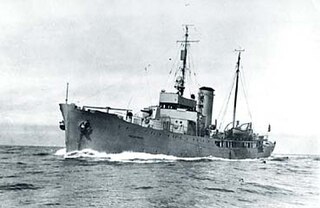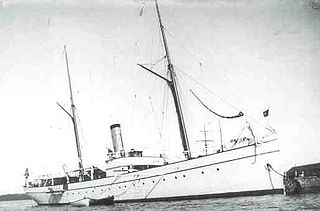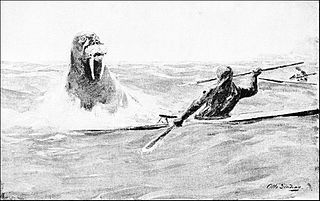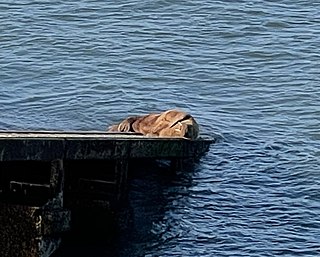
Svalbard, previously known as Spitsbergen or Spitzbergen, is a Norwegian archipelago that lies at the convergence of the Arctic Ocean with the Atlantic Ocean. North of mainland Europe, it lies about midway between the northern coast of Norway and the North Pole. The islands of the group range from 74° to 81° north latitude, and from 10° to 35° east longitude. The largest island is Spitsbergen, followed in size by Nordaustlandet, Edgeøya and Barentsøya. Bjørnøya or Bear Island is the most southerly island in the territory, situated some 147 km south of Spitsbergen. Other small islands in the group include Hopen to the southeast of Edgeøya, Kongsøya and Svenskøya in the east, and Kvitøya to the northeast. The largest settlement is Longyearbyen, situated in Isfjorden on the west coast of Spitsbergen.

The walrus is a large pinniped marine mammal with discontinuous distribution about the North Pole in the Arctic Ocean and subarctic seas of the Northern Hemisphere. It is the only extant species in the family Odobenidae and genus Odobenus. This species is subdivided into two subspecies: the Atlantic walrus, which lives in the Atlantic Ocean, and the Pacific walrus, which lives in the Pacific Ocean.

The Oslofjord is an inlet in southeastern Norway. The 120-kilometre (75 mi) fjord begins at the small village of Bonn in Frogn Municipality and stretching northwards to the city of Oslo, and then curving to the east and then south again. It then flows south to an imaginary line running between the Torbjørnskjær Lighthouse and Færder Lighthouse where it becomes part of the Skagerrak strait. The Skagerrak connects the North Sea and the Kattegat sea area, which leads to the Baltic Sea. The Oslofjord is not a fjord in the geological sense, but in the Norwegian language, the term fjord can refer to a wide range of waterways including inlets such as this one.

Gjøa is a museum ship and was the first vessel to transit the Northwest Passage. With a crew of six, Roald Amundsen traversed the passage in a three-year journey, finishing in 1906.

Pol III was a patrol boat of the Royal Norwegian Navy, used for guarding the inlet of the Oslofjord in early April 1940. She was a small vessel, originally a whaler, of 214 tons. She is best known for being the first Norwegian unit to engage the German invasion forces during the 1940 Operation Weserübung.

Fridtjof Nansen was the first ship in the Norwegian armed forces to be built specially to perform coast guard and fishery protection duties in the Arctic. She saw service in the Second World War with the Royal Norwegian Navy until she ran aground on an unmarked shallow at Jan Mayen in November 1940.

The minelayer HNoMS Frøya was built for the Royal Norwegian Navy by the naval shipyard in Horten during World War I, with yard number 108. A fast ship for her time, she was kept in service until the German invasion of Norway in 1940. At some point between her commissioning and 1940, a 76 mm gun was added to her armaments. Frøya was the first purpose-built minelayer commissioned into the RNoN.
Vollen is a part of the Asker municipality in Akershus county, Norway. For statistical purposes, it is usually treated as part of the Oslo urban area. It is mainly a residential area, though the area has a café, a restaurant, several art galleries, a primary school and secondary school.

HNoMS Rauma was an Otra-class minesweeper built in 1939 for the Royal Norwegian Navy. Captured by the Germans during the 1940 invasion of Norway and renamed Kamerun, she was returned to the Norwegians after the end of the Second World War and recommissioned in 1947. Rauma remained in service until being sold for scrapping in 1963.

Arctic Tale is a 2007 American documentary film from the National Geographic Society about the life cycle of a walrus and her calf, and a polar bear and her cubs, in a similar vein to the 2005 hit production March of the Penguins, which was adapted for an English-language release by National Geographic. It was directed by Adam Ravetch and Sarah Robertson and is narrated by Queen Latifah. The animal characters named in the movie, "Nanu" the female polar bear and "Seela" the female walrus, are based on composites of animals in their species, as noted at the end of the film.

HNoMS Heimdal was a Norwegian warship built at Akers mekaniske verksted in Kristiania, Norway in 1892 with build number 137.

MS Saga is a cruiseferry owned by the Swedish shipping company Stena Line which it operated mainly on their route connecting Oslo, Norway to Frederikshavn, Denmark until March 2020, when that route was closed down. She was built as MS Silvia Regina in 1981 by Wärtsilä in Turku, Finland, for Rederi AB Svea for use in Silja Line traffic. The ship joined the Stena Line fleet in 1991, originally with the name MS Stena Britannica.

MS Oslofjord was an ocean liner built in 1938 by A/G Weser Shipbuilders, Bremen, Germany, for Norwegian America Line. She was of 18,673 gross register tons and could carry 860 passengers. She would have an uneventful career until 1939 were two separate incidents happened. One from 27 April 1939, where she collided with an American pilot boat, and another where she struck a mine sinking her.
Roy Nielsen was a Norwegian resistance member during World War II, a member of Milorg and involved in propaganda and sabotage. Among his sabotage operations was the destruction of 25 Messerschmitt fighter aircraft and 150 engines stored in a bus garage in Oslo, on 14 August 1944, together with Max Manus, Gunnar Sønsteby and others. Together with Max Manus he succeeded in sinking the German troop ship SS Donau in the Oslofjord 16 January 1945, by placing magnetic limpet mines with time delay on the ship's side.

Frank Bakke-Jensen is a Norwegian politician for the Conservative Party. He served as minister of defence from 2017 to 2021, and minister of European affairs from 2016 to 2017. He was mayor of Båtsfjord Municipality from 2007 until his election to the Storting from Finnmark in 2009. Bakke-Jensen formerly worked as a ship's electrician between Hammerfest and Tromsø, and has also worked as a teacher and self-employed pilot at Båtsfjord Airport. He has also performed military service in the UN Lebanon conflict.

The Action in the Oslofjord occurred late on 8 April 1940 in World War II. As Kampfgruppe 5 of the German invasion force proceeded towards Oslo, it encountered Norwegian defences in the Oslofjord. During a short exchange that resulted in the first Norwegian casualty of the war, the Germans managed to push through down to Drøbak Sound, where they would face more determined resistance.

Walrus attacks are attacks inflicted upon humans, other walruses and other animals by the walrus. They have been documented in the Arctic by the Inuit and by European explorers, both on land and at sea. The Greenland Inuit refer to the red walrus as saanniartoq, "the one who turns against one".
Events in the year 2022 in Norway.

Wally the Walrus, also known as Wally the Wandering Walrus, is a male arctic walrus who attracted much media attention for appearing, and hauling out, during 2021 in several locations across the coast of western Europe, mainly Ireland and Britain, far away from the typical range of a walrus. He is estimated to weigh around 800 kilograms (1,800 lb).
Stena, also known as the walrus of Hamina, was the nickname of a female walrus who, in July 2022, died while being transported in Finland.
















